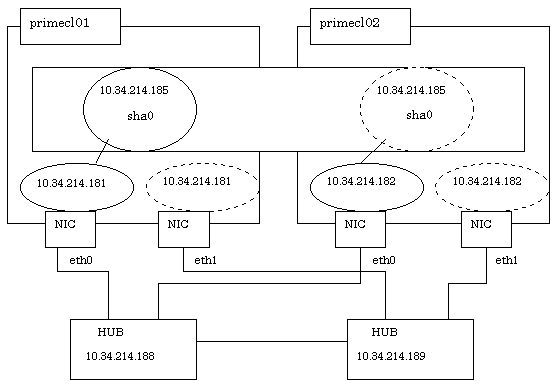

| PRIMECLUSTER Installation and Administration Guide 4.1 (for Linux) |
Contents
Index
 
|
| Part 2 Installation | > Chapter 6 Building Cluster Applications | > 6.2 Initial GLS Setup |
For information on the initial GLS setup, see "Chapter 5 Operation on Cluster System" in the "PRIMECLUSTER Global Link Services Configuration and Administration Guide 4.1 : Redundant Line Control Function."
This section describes how to set up "the Single system without NIC sharing of the NIC switching mode (IPv4)" that GLS (redundant line control function) provides. This procedure is described in the example below.
The setup values correspond to those on the "GLS Setup Worksheet."

 Operation Procedure:
Operation Procedure: If the OPERATING node is [HOST-primecl01]
If the OPERATING node is [HOST-primecl01]10.34.214.185 takeoverIP # Virtual IP 10.34.214.181 primecl01 # primecl01 Physical IP 10.34.214.182 primecl02 # primecl02 Physical IP 10.34.214.188 swhub1 # primary HUB IP 10.34.214.189 swhub2 # secondary HUB IP
Contents of /etc/sysconfig/network-scripts/ifcfg-eth0
DEVICE=eth0 BOOTPROTO=static HWADDR=XX:XX:XX:XX:XX:XX HOTPLUG=no BROADCAST=10.34.214.255 IPADDR=10.34.214.181 NETMASK=255.255.255.0 NETWORK=10.34.214.0 ONBOOT=yes TYPE=Ethernet
Contents of /etc/sysconfig/network-scripts/ifcfg-eth1
DEVICE=eth1 HWADDR=XX:XX:XX:XX:XX:XX HOTPLUG=no ONBOOT=no TYPE=Ethernet

If you specify "HWADDR=XX:XX:XX:XX:XX:XX" in the setting for the physical interfaces bundled by GLS (/etc/sysconfig/network-scripts/ifcfg-ethX file), add the "HOTPLUG=no" setting.
NETWORKING=yes NETWORKING_IPV6=no
Run the following command and reboot the system. After rebooting the system, verify eth0 is enabled using "ifconfig" command.
# /sbin/shutdown -r now
For the underlined parameter, specify the network address and the subnet mask of the virtual interface.
# /opt/FJSVhanet/usr/sbin/hanetmask create -i 10.34.214.0 -m 255.255.255.0
Check that the facility has been set up correctly.
# /opt/FJSVhanet/usr/sbin/hanetmask print

For details on the subnet mask value, see "hanetmask command" in the "PRIMECLUSTER Global Link Services Configuration and Administration Guide 4.1 : Redundant Line Control Function."
For the underlined parameter, specify the physical IP address of the node.
# /opt/FJSVhanet/usr/sbin/hanetconfig create -n sha0 -m d -i 10.34.214.185 -e 10.34.214.181 -t eth0,eth1
Check that the virtual interface has been set up correctly.
# /opt/FJSVhanet/usr/sbin/hanetconfig print
For the underlined parameter, specify the IP addresses of the hubs to be monitored.
# /opt/FJSVhanet/usr/sbin/hanetpoll create -n sha0 -p 10.34.214.188,10.34.214.189 -b off
Check that the facility has been set up correctly.
# /opt/FJSVhanet/usr/sbin/hanetpoll print
# /opt/FJSVhanet/usr/sbin/hanetconfig create -n sha1 -m p -t sha0
Check that the facility has been set up correctly.
# /opt/FJSVhanet/usr/sbin/hanetconfig print
# /opt/FJSVhanet/usr/sbin/hanethvrsc create -n sha0
Check that the registration has been done correctly.
# /opt/FJSVhanet/usr/sbin/hanethvrsc print
 If the STANDBY node is [HOST-primecl02]
If the STANDBY node is [HOST-primecl02]Contents of /etc/sysconfig/network-scripts/ifcfg-eth0
DEVICE=eth0 BOOTPROTO=static BROADCAST=10.34.214.255 HWADDR=XX:XX:XX:XX:XX:XX HOTPLUG=no IPADDR=10.34.214.182 NETMASK=255.255.255.0 NETWORK=10.34.214.0 ONBOOT=yes TYPE=Ethernet
Contents of /etc/sysconfig/network-scripts/ifcfg-eth1
DEVICE=eth1 HWADDR=XX:XX:XX:XX:XX:XX HOTPLUG=no ONBOOT=no TYPE=Ethernet

If you specify "HWADDR=XX:XX:XX:XX:XX:XX" in the setting for the physical interfaces bundled by GLS (/etc/sysconfig/network-scripts/ifcfg-ethX file), add the "HOTPLUG=no" setting.
NETWORKING=yes NETWORKING_IPV6=no
Run the following command and reboot the system. After rebooting the system, verify eth0 is enabled using "ifconfig" command.
# /sbin/shutdown -r now
For the underlined parameter, specify the network address and the subnet mask of the virtual interface.
# /opt/FJSVhanet/usr/sbin/hanetmask create -i 10.34.214.0 -m 255.255.255.0
Check that the facility has been set up correctly.
# /opt/FJSVhanet/usr/sbin/hanetmask print

For details on the subnet mask value, see "hanetmask command" in the "PRIMECLUSTER Global Link Services Configuration and Administration Guide 4.1 : Redundant Line Control Function."
For the underlined parameter, specify the physical IP address of the node.
# /opt/FJSVhanet/usr/sbin/hanetconfig create -n sha0 -m d -i 10.34.214.185 -e 10.34.214.182 -t eth0,eth1
Check that the virtual interface has been set up correctly.
# /opt/FJSVhanet/usr/sbin/hanetconfig print
In the underlined parameter, specify the IP addresses of the hubs to be monitored.
# /opt/FJSVhanet/usr/sbin/hanetpoll create -n sha0 -p 10.34.214.188,10.34.214.189 -b off
Check that the facility has been set up correctly.
# /opt/FJSVhanet/usr/sbin/hanetpoll print
# /opt/FJSVhanet/usr/sbin/hanetconfig create -n sha1 -m p -t sha0
Check that the facility has been set up correctly.
# /opt/FJSVhanet/usr/sbin/hanetconfig print
# /opt/FJSVhanet/usr/sbin/hanethvrsc create -n sha0
Check that the resources have been set up correctly.
# /opt/FJSVhanet/usr/sbin/hanethvrsc print
 Post-setup processing
Post-setup processingAfter the OPERATING and STANDBY node setup is done, create the Gls resources and register them to the cluster application.
For details, see "Setting Up Gls Resources" and "Setting Up Cluster Applications."
You also need to reboot the system after registering the cluster application. Then, start RMS and check the RMS tree to confirm whether the Gls resources are displayed correctly. For details, see "RMS Tree."
The Gls resource name is displayed as GlsX (X is integer).

For information on GLS (redundant line control function) and other operation modes, see "Appendix B Examples of Setting Up" in the "PRIMECLUSTER Global Link Services Configuration and Administration Guide 4.1 : Redundant Line Control Function."
Contents
Index
 
|